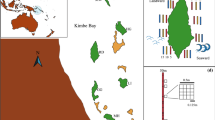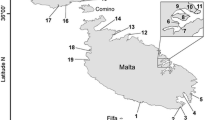Abstract
Bryozoans are colonial invertebrates that often dominate epibenthic assemblages on the lower surfaces of hard substrata. Competition among neighbouring organisms is usually a critical process regulating biodiversity, and hard substrata have proved to be a suitable model habitat to analyse spatial interactions. We explored the relationships among abundance, species richness, diversity, competitive ability, coverage, available surface, depth and substratum size in an assemblage of bryozoans encrusting pebbles and cobbles in a bank off the eastern mouth of the Strait of Magellan. We also tested whether overgrowth competition can be regarded as hierarchical, and whether the species abundance distribution shows a mode of rare species and a decreasing frequency of increasingly abundant species. Abundance, species richness, diversity and overgrowth competition were highest on the largest substrata. Smaller pebbles tended to be encrusted by the commonest bryozoans, while the rarest species were mainly found on relatively larger clasts. A high proportion of the lower surfaces of most substrata was available for growth. Diversity values of relatively shallow stations were lower than expected under Caswell’s neutral model. Interspecific competition was hierarchical, but the abundance of colonies was not related to the competitive ability of each species. The species abundance distribution was bimodal, with a main mode of rare species and a second one partly composed of relatively abundant bryozoans with poor competitive abilities. This study shows that even in an encrusting assemblage where competition is hierarchical, the weakest competitors persist and the dominant species are far from being capable of monopolizing space.








Similar content being viewed by others
References
Barnes, D. K. A., 2002. Clade perseverance from Mesozoic to Present: a multidisciplinary approach to interpretation of pattern and process. The Biological Bulletin 203: 161–172.
Barnes, D. K. A., 2006. Temporal-spatial stability of competition in marine boulder fields. Marine Ecology Progress Series 314: 15–23.
Barnes, D. K. A. & R. Arnold, 2001. Competition, sub-lethal mortality and diversity on Southern Ocean coastal rock communities. Polar Biology 24: 447–454.
Barnes, D. K. A. & A. Clarke, 1998. The ecology of an assemblage dominant: the encrusting bryozoan Fenestrulina rugula. Invertebrate Biology 117: 331–340.
Barnes, D. K. A. & P. Kuklinski, 2003. High polar spatial competition: extreme hierarchies at extreme latitude. Marine Ecology Progress Series 259: 17–28.
Barnes, D. K. A. & C. Lehane, 2001. Competition, mortality and diversity in South Atlantic coastal boulder communities. Polar Biology 24: 200–208.
Barnes, D. K. A. & P. Rothery, 1996. Competition in encrusting Antarctic bryozoan assemblages: outcomes, influences and implications. Journal of Experimental Marine Biology and Ecology 196: 267–284.
Barnes, D. K. A., P. Rothery & A. Clarke, 1996. Colonisation and development in encrusting communities from the Antarctic intertidal and sublittoral. Journal of Experimental Marine Biology and Ecology 196: 251–265.
Buss, L. W., 1979. Habitat selection, directional growth and spatial refuges: why colonial animals have more hiding places. In Larwood, G. & B. R. Rosen (eds), Biology and Systematics of Colonial Organisms. Academic Press, London and New York: 459–497.
Buss, L. W., 1980. Competitive intransitivity and size-frequency distributions of interacting populations. Proceedings of the National Academy of Sciences of the United States of America 77: 5355–5359.
Caswell, H., 1976. Community structure: a neutral model analysis. Ecological Monographs 46: 327–354.
Chave, J., 2004. Neutral theory and community ecology. Ecology Letters 7: 241–253.
Chesson, P., 2000. Mechanisms of maintenance of species diversity. Annual Review of Ecology and Systematics 31: 343–366.
Clarke, K. R. & R. M. Warwick, 2001. Change in Marine Communities: An Approach to Statistical Analysis and Interpretation, 2nd edn. PRIMER-E Ltd, Plymouth.
Connell, J. H., 1978. Diversity in tropical rain forests and coral reefs. Science 199: 1302–1310.
Dornelas, M. & S. R. Connolly, 2008. Multiple modes in a coral species abundance distribution. Ecology Letters 11: 1008–1016.
Glasby, T. M. & S. D. Connell, 2001. Orientation and position of substrata have large effects on epibiotic assemblages. Marine Ecology Progress Series 214: 127–135.
Gray, J. S., A. Bjørgesæter & K. I. Ugland, 2005. The impact of rare species on natural assemblages. Journal of Animal Ecology 74: 1131–1139.
Gray, J. S., A. Bjørgesæter & K. I. Ugland, 2006. On plotting species abundance distributions. Journal of Animal Ecology 75: 752–756.
Irving, A. D. & S. D. Connell, 2002. Sedimentation and light penetration interact to maintain heterogeneity of subtidal habitats: algal versus invertebrate dominated assemblages. Marine Ecology Progress Series 245: 83–91.
Jackson, J. B. C., 1979a. Morphological strategies of sessile animals. In Larwood, G. & B. R. Rosen (eds), Biology and Systematics of Colonial Organisms. Academic Press, London and New York: 499–555.
Jackson, J. B. C., 1979b. Overgrowth competition between encrusting cheilostome ectoprocts in a Jamaican cryptic reef environment. Journal of Animal Ecology 48: 805–823.
Kuklinski, P., B. Gulliksen, O. J. Lønne & J. M. Weslawski, 2006. Substratum as a structuring influence on assemblages of Arctic bryozoans. Polar Biology 29: 652–661.
Lambshead, P. J. D. & H. M. Platt, 1988. Analysing disturbance with the Ewens/Caswell neutral model: theoretical review and practical assessment. Marine Ecology Progress Series 43: 31–41.
Levin, S. A. & R. T. Paine, 1974. Disturbance, patch formation, and community structure. Proceedings of the National Academy of Sciences of the United States of America 71: 2744–2747.
López Gappa, J., 1989. Overgrowth competition in an assemblage of encrusting bryozoans settled on artificial substrata. Marine Ecology Progress Series 51: 121–130.
López Gappa, J. & N. A. Landoni, 2009. Space utilisation patterns of bryozoans on the Patagonian scallop Psychrochlamys patagonica. Scientia Marina 73: 161–171.
Magurran, A. E. & P. A. Henderson, 2003. Explaining the excess of rare species in natural species abundance distributions. Nature 422: 714–716.
Maughan, B. C., 2001. The effect of sedimentation and light on recruitment and development of a temperate, subtidal, epifaunal community. Journal of Experimental Marine Biology and Ecology 256: 59–71.
Maughan, B. C. & D. K. A. Barnes, 2000. Epilithic boulder communities of Lough Hyne, Ireland: the influences of water movement and sediment. Journal of the Marine Biological Association of the United Kingdom 80: 767–776.
McGill, B. J., 2003. Does Mother Nature really prefer rare species or are log-left-skewed SADs a sampling artefact? Ecology Letters 6: 766–773.
McGill, B. J., R. S. Etienne, J. S. Gray, D. Alonso, M. J. Anderson, H. K. Benecha, M. Dornelas, B. J. Enquist, J. L. Green, F. He, A. H. Hurlbert, A. E. Magurran, P. A. Marquet, B. A. Maurer, A. Ostling, C. U. Soykan, K. I. Ugland & E. P. White, 2007. Species abundance distributions: moving beyond single prediction theories to integration within an ecological framework. Ecology Letters 10: 995–1015.
McGuinness, K. A., 1987a. Disturbance and organisms on boulders I. Patterns in the environment and the community. Oecologia 71: 409–419.
McGuinness, K. A., 1987b. Disturbance and organisms on boulders II. Causes of patterns in diversity and abundance. Oecologia 71: 420–430.
McKinney, F. K., 1993. A faster-paced world?: contrasts in biovolume and life-process rates in cyclostome (Class Stenolaemata) and cheilostome (Class Gymnolaemata) bryozoans. Paleobiology 19: 335–351.
Medeiros, C. & B. Kjerfve, 1988. Tidal characteristics of the Strait of Magellan. Continental Shelf Research 8: 947–960.
Michelato, A., E. Accerboni & P. Berger, 1991. Current meter observations in the eastern and central sectors of the Strait of Magellan. Bollettino di Oceanologia Teorica ed Applicata 9: 261–271.
Okamura, B., J. G. Harmelin & J. B. C. Jackson, 2001. Refuges revisited. Enemies versus flow and feeding as determinants of sessile animal distribution and form. In Jackson, J. B. C., S. Lidgard & F. K. McKinney (eds), Evolutionary Patterns. Growth, Form and Tempo in the Fossil Record. The University of Chicago Press, Chicago: 61–93.
Paine, R. T., 1984. Ecological determinism in the competition for space. Ecology 65: 1339–1348.
Platt, H. M. & P. J. D. Lambshead, 1985. Neutral model analysis of patterns of marine benthic species diversity. Marine Ecology Progress Series 24: 75–81.
Preston, F. W., 1948. The commonness, and rarity, of species. Ecology 29: 254–283.
Sokal, R. R. & F. J. Rohlf, 1981. Biometry, 2nd edn. WH Freeman & Co, New York.
Sousa, W. P., 1979a. Disturbance in marine intertidal boulder fields: the nonequilibrium maintenance of species diversity. Ecology 60: 1225–1239.
Sousa, W. P., 1979b. Experimental investigations of disturbance and ecological succession in a rocky intertidal algal community. Ecological Monographs 49: 227–254.
Sousa, W. P., 1984. The role of disturbance in natural communities. Annual Review of Ecology and Systematics 15: 353–391.
Stark, J. S., 2008. Patterns of higher taxon colonisation and development in sessile marine benthic assemblages at Casey Station, Antarctica, and their use in environmental monitoring. Marine Ecology Progress Series 365: 77–89.
Stebbing, A. R. D., 1973a. Competition for space between the epiphytes of Fucus serratus L. Journal of the Marine Biological Association of the United Kingdom 53: 247–261.
Stebbing, A. R. D., 1973b. Observations on colony overgrowth and spatial competition. In Larwood, G. P. (ed.), Living and Fossil Bryozoa. Recent Advances in Research. Academic Press, London and New York: 173–183.
Tanaka, M. & K. Nandakumar, 1994. Measurement of the degree of intransitivity in a community of sessile organisms. Journal of Experimental Marine Biology and Ecology 182: 85–95.
Taylor, P. D. & M. A. Wilson, 2003. Palaeoecology and evolution of marine hard substrate communities. Earth-Science Reviews 62: 1–103.
Tilman, D., 1994. Competition and biodiversity in spatially structured habitats. Ecology 75: 2–16.
Turner, S. J. & C. D. Todd, 1994. Competition for space in encrusting bryozoan assemblages: the influence of encounter angle, site and year. Journal of the Marine Biological Association of the United Kingdom 74: 603–622.
Wahl, M. & O. Mark, 1999. The predominantly facultative nature of epibiosis: experimental and observational evidence. Marine Ecology Progress Series 187: 59–66.
Acknowledgments
Néstor Landoni helped us in various stages of this study. We are grateful to the crew of the PSV Golondrina de Mar for assistance during the field survey and to CONICET for financial support (PIP 2010-2012 No. 11220090100291).
Author information
Authors and Affiliations
Corresponding author
Additional information
Handling editor: Stuart Jenkins
Rights and permissions
About this article
Cite this article
Centurión, R., López Gappa, J. Bryozoan assemblages on hard substrata: species abundance distribution and competition for space. Hydrobiologia 658, 329–341 (2011). https://doi.org/10.1007/s10750-010-0503-5
Received:
Revised:
Accepted:
Published:
Issue Date:
DOI: https://doi.org/10.1007/s10750-010-0503-5




